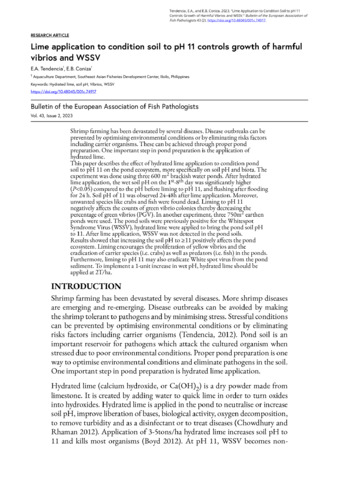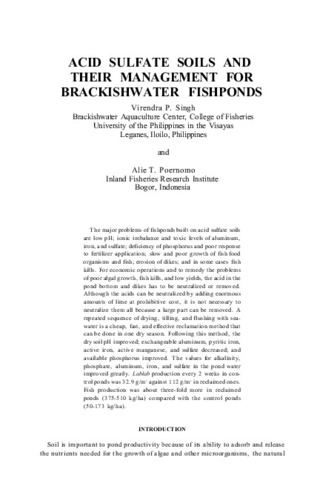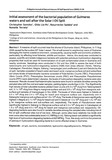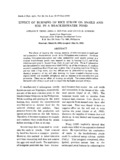Lime application to condition soil to pH 11 controls growth of harmful vibrios and WSSV
- Global styles
- MLA
- Vancouver
- Elsevier - Harvard
- APA
- Help

Download URL
eafpbulletin.scholasticahq.com日付
2023-05-26Page views
771AGROVOC keyword
Taxonomic term
Metadata
アイテムの詳細レコードを表示する
Share
抄録
Shrimp farming has been devastated by several diseases. Disease outbreaks can be prevented by optimising environmental conditions or by eliminating risks factors including carrier organisms. These can be achieved through proper pond preparation. One important step in pond preparation is the application of hydrated lime.
This paper describes the effect of hydrated lime application to condition pond soil to pH 11 on the pond ecosystem, more specifically on soil pH and biota. The experiment was done using three 600 m2 brackish water ponds. After hydrated lime application, the wet soil pH on the 1st-8th day was significantly higher (P<0.05) compared to the pH before liming to pH 11, and flushing after flooding for 24 h. Soil pH of 11 was observed 24-48h after lime application. Moreover, unwanted species like crabs and fish were found dead. Liming to pH 11 negatively affects the counts of green vibrio colonies thereby decreasing the percentage of green vibrios (PGV). In another experiment, three 750m2 earthen ponds were used. The pond soils were previously positive for the Whitespot Syndrome Virus (WSSV), hydrated lime were applied to bring the pond soil pH to 11. After lime application, WSSV was not detected in the pond soils.
Results showed that increasing the soil pH to ≥11 positively affects the pond ecosystem. Liming encourages the proliferation of yellow vibrios and the eradication of carrier species (i.e. crabs) as well as predators (i.e. fish) in the ponds. Furthermore, liming to pH 11 may also eradicate White spot virus from the pond sediment. To implement a 1-unit increase in wet pH, hydrated lime should be applied at 2T/ha.
Keywords
Hydrated lime soil pH Vibrios WSSVSuggested Citation
Tendencia, E. A., & Coniza, E. B. (2023). Lime application to condition soil to pH 11 controls growth of harmful vibrios and WSSV. Bulletin of the European Association of Fish Pathologists, 43(2). https://doi.org/10.48045/001c.74917
Type
ArticleISSN
0108-0288Collections
- Journal Articles [1258]
Related items
Showing items related by title, author, creator and subject.
-
Acid sulfate soils and their management for brackishwater fishponds
Singh, Virendra P.; Poernomo, Alie T. (Aquaculture Department, Southeast Asian Fisheries Development Center; International Development Research Centre; Island Publishing House, Inc., 1984)The major problems of fishponds build on acid sulfate soils are low pH; ionic imbalance and toxic levels of aluminum, iron, and sulfate; deficiency of phosphorus and poor response to fertilizer application; slow and poor ... -
Initial assessment of the bacterial population of Guimaras waters and soil after the Solar I oil spill
Sombito, Christopher; Lio-Po, Gilda; Sadaba, Resurrecion; Torreta, Romelie (University of the Philippines Visayas, 2009)A massive oil spill occurred near the shores of Guimaras Island, Philippines in 11 Aug 2006 caused by the Sunken MT Solar I vessel. The oil spill spread to neighboring towns of Guimaras damaging the marine coastal environment, ... -
Effect of burning of rice straw on snails and soil in a brackishwater pond
Triño, Avelino T.; Bolivar, Edna C.; Gerochi, Dante D. (Serials Publications, 1993)The effects of burning the varying amounts of dried rice straw on snails and soil properties in brackishwater ponds in the Philippines were evaluated. Cerithium tenellum, Telescopium telescopium and other unidentified snail ...







